
Illustrative Math Alignment: Grade 6 Unit 1
Dividing Fractions
Lesson 4: How Many Groups? (Part 1)
Use the following Media4Math resources with this Illustrative Math lesson.
| Thumbnail Image | Title | Body | Curriculum Nodes |
|---|---|---|---|

|
Math Example--Arithmetic--Division and Unknown Factors: Example 2 | Math Example--Arithmetic--Division and Unknown Factors: Example 2TopicArithmetic DescriptionSimplify 24 ÷ 8 by using the inverse operation of multiplication. The example illustrates the method of column multiplication. The caption explains the process step-by-step, emphasizing the sequential multiplication and any necessary regrouping. In general, column multiplication is a foundational arithmetic skill that develops a student's ability to handle larger numbers systematically. Examples in this collection present varied scenarios, building confidence through exposure to different configurations of numbers. |
Division Facts and Multiplication Facts |

|
Math Example--Arithmetic--Division and Unknown Factors: Example 2 | Math Example--Arithmetic--Division and Unknown Factors: Example 2TopicArithmetic DescriptionSimplify 24 ÷ 8 by using the inverse operation of multiplication. The example illustrates the method of column multiplication. The caption explains the process step-by-step, emphasizing the sequential multiplication and any necessary regrouping. In general, column multiplication is a foundational arithmetic skill that develops a student's ability to handle larger numbers systematically. Examples in this collection present varied scenarios, building confidence through exposure to different configurations of numbers. |
Division Facts and Multiplication Facts |

|
Math Example--Arithmetic--Division and Unknown Factors: Example 2 | Math Example--Arithmetic--Division and Unknown Factors: Example 2TopicArithmetic DescriptionSimplify 24 ÷ 8 by using the inverse operation of multiplication. The example illustrates the method of column multiplication. The caption explains the process step-by-step, emphasizing the sequential multiplication and any necessary regrouping. In general, column multiplication is a foundational arithmetic skill that develops a student's ability to handle larger numbers systematically. Examples in this collection present varied scenarios, building confidence through exposure to different configurations of numbers. |
Division Facts and Multiplication Facts |

|
Math Example--Arithmetic--Division and Unknown Factors: Example 2 | Math Example--Arithmetic--Division and Unknown Factors: Example 2TopicArithmetic DescriptionSimplify 24 ÷ 8 by using the inverse operation of multiplication. The example illustrates the method of column multiplication. The caption explains the process step-by-step, emphasizing the sequential multiplication and any necessary regrouping. In general, column multiplication is a foundational arithmetic skill that develops a student's ability to handle larger numbers systematically. Examples in this collection present varied scenarios, building confidence through exposure to different configurations of numbers. |
Division Facts and Multiplication Facts |
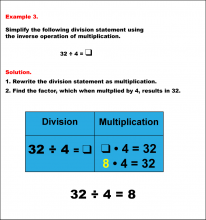
|
Math Example--Arithmetic--Division and Unknown Factors: Example 3 | Math Example--Arithmetic--Division and Unknown Factors: Example 3TopicArithmetic DescriptionSimplify 32 ÷ 4 by using the inverse operation of multiplication. The example illustrates the method of column multiplication. The caption explains the process step-by-step, emphasizing the sequential multiplication and any necessary regrouping. In general, column multiplication is a foundational arithmetic skill that develops a student's ability to handle larger numbers systematically. Examples in this collection present varied scenarios, building confidence through exposure to different configurations of numbers. |
Division Facts and Multiplication Facts |

|
Math Example--Arithmetic--Division and Unknown Factors: Example 3 | Math Example--Arithmetic--Division and Unknown Factors: Example 3TopicArithmetic DescriptionSimplify 32 ÷ 4 by using the inverse operation of multiplication. The example illustrates the method of column multiplication. The caption explains the process step-by-step, emphasizing the sequential multiplication and any necessary regrouping. In general, column multiplication is a foundational arithmetic skill that develops a student's ability to handle larger numbers systematically. Examples in this collection present varied scenarios, building confidence through exposure to different configurations of numbers. |
Division Facts and Multiplication Facts |

|
Math Example--Arithmetic--Division and Unknown Factors: Example 3 | Math Example--Arithmetic--Division and Unknown Factors: Example 3TopicArithmetic DescriptionSimplify 32 ÷ 4 by using the inverse operation of multiplication. The example illustrates the method of column multiplication. The caption explains the process step-by-step, emphasizing the sequential multiplication and any necessary regrouping. In general, column multiplication is a foundational arithmetic skill that develops a student's ability to handle larger numbers systematically. Examples in this collection present varied scenarios, building confidence through exposure to different configurations of numbers. |
Division Facts and Multiplication Facts |

|
Math Example--Arithmetic--Division and Unknown Factors: Example 3 | Math Example--Arithmetic--Division and Unknown Factors: Example 3TopicArithmetic DescriptionSimplify 32 ÷ 4 by using the inverse operation of multiplication. The example illustrates the method of column multiplication. The caption explains the process step-by-step, emphasizing the sequential multiplication and any necessary regrouping. In general, column multiplication is a foundational arithmetic skill that develops a student's ability to handle larger numbers systematically. Examples in this collection present varied scenarios, building confidence through exposure to different configurations of numbers. |
Division Facts and Multiplication Facts |

|
Math Example--Arithmetic--Division and Unknown Factors: Example 3 | Math Example--Arithmetic--Division and Unknown Factors: Example 3TopicArithmetic DescriptionSimplify 32 ÷ 4 by using the inverse operation of multiplication. The example illustrates the method of column multiplication. The caption explains the process step-by-step, emphasizing the sequential multiplication and any necessary regrouping. In general, column multiplication is a foundational arithmetic skill that develops a student's ability to handle larger numbers systematically. Examples in this collection present varied scenarios, building confidence through exposure to different configurations of numbers. |
Division Facts and Multiplication Facts |

|
Math Example--Arithmetic--Division and Unknown Factors: Example 3 | Math Example--Arithmetic--Division and Unknown Factors: Example 3TopicArithmetic DescriptionSimplify 32 ÷ 4 by using the inverse operation of multiplication. The example illustrates the method of column multiplication. The caption explains the process step-by-step, emphasizing the sequential multiplication and any necessary regrouping. In general, column multiplication is a foundational arithmetic skill that develops a student's ability to handle larger numbers systematically. Examples in this collection present varied scenarios, building confidence through exposure to different configurations of numbers. |
Division Facts and Multiplication Facts |
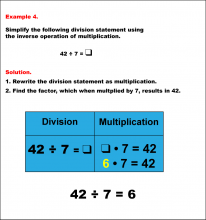
|
Math Example--Arithmetic--Division and Unknown Factors: Example 4 | Math Example--Arithmetic--Division and Unknown Factors: Example 4TopicArithmetic DescriptionSimplify 42 ÷ 7 by using the inverse operation of multiplication. The example illustrates the method of column multiplication. The caption explains the process step-by-step, emphasizing the sequential multiplication and any necessary regrouping. In general, column multiplication is a foundational arithmetic skill that develops a student's ability to handle larger numbers systematically. Examples in this collection present varied scenarios, building confidence through exposure to different configurations of numbers. |
Division Facts and Multiplication Facts |

|
Math Example--Arithmetic--Division and Unknown Factors: Example 4 | Math Example--Arithmetic--Division and Unknown Factors: Example 4TopicArithmetic DescriptionSimplify 42 ÷ 7 by using the inverse operation of multiplication. The example illustrates the method of column multiplication. The caption explains the process step-by-step, emphasizing the sequential multiplication and any necessary regrouping. In general, column multiplication is a foundational arithmetic skill that develops a student's ability to handle larger numbers systematically. Examples in this collection present varied scenarios, building confidence through exposure to different configurations of numbers. |
Division Facts and Multiplication Facts |

|
Math Example--Arithmetic--Division and Unknown Factors: Example 4 | Math Example--Arithmetic--Division and Unknown Factors: Example 4TopicArithmetic DescriptionSimplify 42 ÷ 7 by using the inverse operation of multiplication. The example illustrates the method of column multiplication. The caption explains the process step-by-step, emphasizing the sequential multiplication and any necessary regrouping. In general, column multiplication is a foundational arithmetic skill that develops a student's ability to handle larger numbers systematically. Examples in this collection present varied scenarios, building confidence through exposure to different configurations of numbers. |
Division Facts and Multiplication Facts |

|
Math Example--Arithmetic--Division and Unknown Factors: Example 4 | Math Example--Arithmetic--Division and Unknown Factors: Example 4TopicArithmetic DescriptionSimplify 42 ÷ 7 by using the inverse operation of multiplication. The example illustrates the method of column multiplication. The caption explains the process step-by-step, emphasizing the sequential multiplication and any necessary regrouping. In general, column multiplication is a foundational arithmetic skill that develops a student's ability to handle larger numbers systematically. Examples in this collection present varied scenarios, building confidence through exposure to different configurations of numbers. |
Division Facts and Multiplication Facts |

|
Math Example--Arithmetic--Division and Unknown Factors: Example 4 | Math Example--Arithmetic--Division and Unknown Factors: Example 4TopicArithmetic DescriptionSimplify 42 ÷ 7 by using the inverse operation of multiplication. The example illustrates the method of column multiplication. The caption explains the process step-by-step, emphasizing the sequential multiplication and any necessary regrouping. In general, column multiplication is a foundational arithmetic skill that develops a student's ability to handle larger numbers systematically. Examples in this collection present varied scenarios, building confidence through exposure to different configurations of numbers. |
Division Facts and Multiplication Facts |

|
Math Example--Arithmetic--Division and Unknown Factors: Example 4 | Math Example--Arithmetic--Division and Unknown Factors: Example 4TopicArithmetic DescriptionSimplify 42 ÷ 7 by using the inverse operation of multiplication. The example illustrates the method of column multiplication. The caption explains the process step-by-step, emphasizing the sequential multiplication and any necessary regrouping. In general, column multiplication is a foundational arithmetic skill that develops a student's ability to handle larger numbers systematically. Examples in this collection present varied scenarios, building confidence through exposure to different configurations of numbers. |
Division Facts and Multiplication Facts |
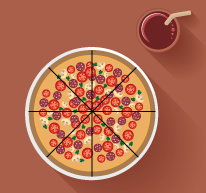
|
Math Clip Art: Fractions--Pizza Slices--Full Eighths | Math Clip Art: Fractions--Pizza Slices--Full EighthsTopicFractions DescriptionThis math clip art image is part of a comprehensive series designed to illustrate fraction models using pizzas. The image depicts a circular pizza divided into eight equal slices, representing the concept of "full eighths." Each slice is clearly defined, making it easy for students to visualize and understand the fraction 8/8, which is equivalent to one whole. |
Identify and Name Fractions |

|
Math Clip Art: Fractions--Pizza Slices--Full Eighths | Math Clip Art: Fractions--Pizza Slices--Full EighthsTopicFractions DescriptionThis math clip art image is part of a comprehensive series designed to illustrate fraction models using pizzas. The image depicts a circular pizza divided into eight equal slices, representing the concept of "full eighths." Each slice is clearly defined, making it easy for students to visualize and understand the fraction 8/8, which is equivalent to one whole. |
Identify and Name Fractions |
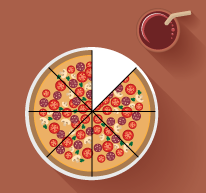
|
Math Clip Art: Fractions--Pizza Slices--Seven Eighths | Math Clip Art: Fractions--Pizza Slices--Seven EighthsTopicFractions DescriptionThis math clip art image is part of a series illustrating fraction models using pizzas. The image shows a circular pizza divided into eight equal slices, with seven slices present and one slice missing. This visual representation effectively demonstrates the fraction seven-eighths (7/8). |
Identify and Name Fractions |

|
Math Clip Art: Fractions--Pizza Slices--Seven Eighths | Math Clip Art: Fractions--Pizza Slices--Seven EighthsTopicFractions DescriptionThis math clip art image is part of a series illustrating fraction models using pizzas. The image shows a circular pizza divided into eight equal slices, with seven slices present and one slice missing. This visual representation effectively demonstrates the fraction seven-eighths (7/8). |
Identify and Name Fractions |
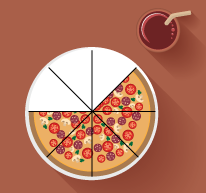
|
Math Clip Art: Fractions--Pizza Slices--Five Eighths | Math Clip Art: Fractions--Pizza Slices--Five EighthsTopicFractions DescriptionThis math clip art image is part of a series that uses pizza slices to model fractions. The image depicts a circular pizza divided into eight equal slices, with five slices present and three missing. This visual representation clearly illustrates the fraction five-eighths (5/8). |
Identify and Name Fractions |

|
Math Clip Art: Fractions--Pizza Slices--Five Eighths | Math Clip Art: Fractions--Pizza Slices--Five EighthsTopicFractions DescriptionThis math clip art image is part of a series that uses pizza slices to model fractions. The image depicts a circular pizza divided into eight equal slices, with five slices present and three missing. This visual representation clearly illustrates the fraction five-eighths (5/8). |
Identify and Name Fractions |
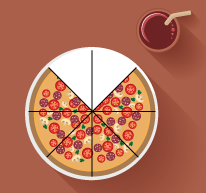
|
Math Clip Art: Fractions--Pizza Slices--Six Eighths | Math Clip Art: Fractions--Pizza Slices--Six EighthsTopicFractions DescriptionThis math clip art image is part of a series that uses pizza slices to model fractions. The image shows a circular pizza divided into eight equal slices, with six slices present and two missing. This visual representation effectively illustrates the fraction six-eighths (6/8). |
Identify and Name Fractions |

|
Math Clip Art: Fractions--Pizza Slices--Six Eighths | Math Clip Art: Fractions--Pizza Slices--Six EighthsTopicFractions DescriptionThis math clip art image is part of a series that uses pizza slices to model fractions. The image shows a circular pizza divided into eight equal slices, with six slices present and two missing. This visual representation effectively illustrates the fraction six-eighths (6/8). |
Identify and Name Fractions |
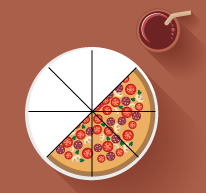
|
Math Clip Art: Fractions--Pizza Slices--Four Eighths | Math Clip Art: Fractions--Pizza Slices--Four EighthsTopicFractions DescriptionThis math clip art image is part of a series that uses pizza slices to model fractions. The image depicts a circular pizza divided into eight equal slices, with four slices present and four missing. This visual representation clearly illustrates the fraction four-eighths (4/8), which is equivalent to 1/2. |
Identify and Name Fractions |

|
Math Clip Art: Fractions--Pizza Slices--Four Eighths | Math Clip Art: Fractions--Pizza Slices--Four EighthsTopicFractions DescriptionThis math clip art image is part of a series that uses pizza slices to model fractions. The image depicts a circular pizza divided into eight equal slices, with four slices present and four missing. This visual representation clearly illustrates the fraction four-eighths (4/8), which is equivalent to 1/2. |
Identify and Name Fractions |
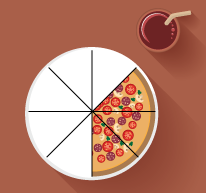
|
Math Clip Art: Fractions--Pizza Slices--Three Eighths | Math Clip Art: Fractions--Pizza Slices--Three EighthsTopicFractions DescriptionThis math clip art belongs to a series illustrating fraction models using pizzas. Displaying three slices out of eight, this image visually represents the fraction three-eighths (3/8). The use of visual aids like pizza fraction models in mathematics education enhances understanding of abstract concepts by relating them to real-world examples. These models provide a tangible basis that can be easily integrated into lessons focused on fractions, enabling discussions around equal parts, fraction addition/subtraction, and common denominators. |
Identify and Name Fractions |

|
Math Clip Art: Fractions--Pizza Slices--Two Eighths | Math Clip Art: Fractions--Pizza Slices--Two EighthsTopicFractions DescriptionThis math clip art image is part of a series illustrating fraction models with pizzas. The image shows a pizza divided into eight equal slices, of which two are shown. This visual representation effectively communicates the fraction two-eighths (2/8), which is equivalent to 1/4. |
Identify and Name Fractions |

|
Math Clip Art: Fractions--Pizza Slices--Two Eighths | Math Clip Art: Fractions--Pizza Slices--Two EighthsTopicFractions DescriptionThis math clip art image is part of a series illustrating fraction models with pizzas. The image shows a pizza divided into eight equal slices, of which two are shown. This visual representation effectively communicates the fraction two-eighths (2/8), which is equivalent to 1/4. |
Identify and Name Fractions |
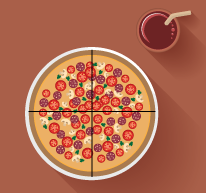
|
Math Clip Art: Fractions--Pizza Slices--Full Fourths | Math Clip Art: Fractions--Pizza Slices--Full FourthsTopicFractions DescriptionThis math clip art image is part of a series illustrating fraction models using pizzas. The image depicts a circular pizza divided into four equal slices, representing the concept of "full fourths." Each slice is clearly defined, making it easy for students to visualize and understand the fraction 4/4, which is equivalent to one whole. |
Identify and Name Fractions |

|
Math Clip Art: Fractions--Pizza Slices--Full Fourths | Math Clip Art: Fractions--Pizza Slices--Full FourthsTopicFractions DescriptionThis math clip art image is part of a series illustrating fraction models using pizzas. The image depicts a circular pizza divided into four equal slices, representing the concept of "full fourths." Each slice is clearly defined, making it easy for students to visualize and understand the fraction 4/4, which is equivalent to one whole. |
Identify and Name Fractions |
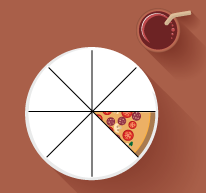
|
Math Clip Art: Fractions--Pizza Slices--One Eighth | Math Clip Art: Fractions--Pizza Slices--One EighthTopicFractions DescriptionThis math clip art image is part of a series that uses pizza slices to model fractions. The image shows a circular pizza divided into eight equal slices, with only one slice present. This visual representation effectively illustrates the fraction one-eighth (1/8). |
Identify and Name Fractions |

|
Math Clip Art: Fractions--Pizza Slices--One Eighth | Math Clip Art: Fractions--Pizza Slices--One EighthTopicFractions DescriptionThis math clip art image is part of a series that uses pizza slices to model fractions. The image shows a circular pizza divided into eight equal slices, with only one slice present. This visual representation effectively illustrates the fraction one-eighth (1/8). |
Identify and Name Fractions |
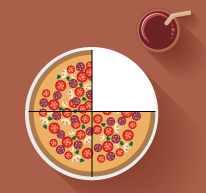
|
Math Clip Art: Fractions--Pizza Slices--Three Fourths | Math Clip Art: Fractions--Pizza Slices--Three FourthsTopicFractions DescriptionThis math clip art image is part of a series that uses pizza slices to model fractions. The image depicts a circular pizza divided into four equal slices, with three slices present and one missing. This visual representation clearly illustrates the fraction three-fourths (3/4). |
Identify and Name Fractions |

|
Math Clip Art: Fractions--Pizza Slices--Three Fourths | Math Clip Art: Fractions--Pizza Slices--Three FourthsTopicFractions DescriptionThis math clip art image is part of a series that uses pizza slices to model fractions. The image depicts a circular pizza divided into four equal slices, with three slices present and one missing. This visual representation clearly illustrates the fraction three-fourths (3/4). |
Identify and Name Fractions |
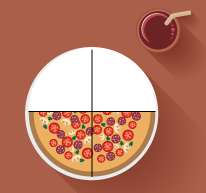
|
Math Clip Art: Fractions--Pizza Slices--Two Fourths | Math Clip Art: Fractions--Pizza Slices--Two FourthsTopicFractions DescriptionThis math clip art image is part of a series illustrating fraction models using pizzas. The image depicts a circular pizza divided into four equal slices, with two slices present and two missing. This visual representation effectively demonstrates the fraction two-fourths (2/4). |
Identify and Name Fractions |

|
Math Clip Art: Fractions--Pizza Slices--Two Fourths | Math Clip Art: Fractions--Pizza Slices--Two FourthsTopicFractions DescriptionThis math clip art image is part of a series illustrating fraction models using pizzas. The image depicts a circular pizza divided into four equal slices, with two slices present and two missing. This visual representation effectively demonstrates the fraction two-fourths (2/4). |
Identify and Name Fractions |
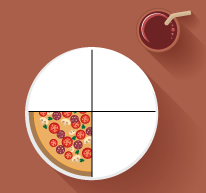
|
Math Clip Art: Fractions--Pizza Slices--One Fourth | Math Clip Art: Fractions--Pizza Slices--One FourthTopicFractions DescriptionThis math clip art image is part of a series that uses pizza slices to model fractions. The image shows a circular pizza divided into four equal slices, with only one slice present. This visual representation effectively illustrates the fraction one-fourth (1/4). |
Identify and Name Fractions |

|
Math Clip Art: Fractions--Pizza Slices--One Fourth | Math Clip Art: Fractions--Pizza Slices--One FourthTopicFractions DescriptionThis math clip art image is part of a series that uses pizza slices to model fractions. The image shows a circular pizza divided into four equal slices, with only one slice present. This visual representation effectively illustrates the fraction one-fourth (1/4). |
Identify and Name Fractions |

|
Math Clip Art: Fractions--Pizza Slices--Five Sixths | Math Clip Art: Fractions--Pizza Slices--Five SixthsTopicFractions DescriptionThis math clip art image is part of a series illustrating fraction models using pizzas. The image shows a circular pizza divided into six equal slices, with five slices present and one missing. This visual representation effectively demonstrates the fraction five-sixths (5/6). |
Identify and Name Fractions |

|
Math Clip Art: Fractions--Pizza Slices--Five Sixths | Math Clip Art: Fractions--Pizza Slices--Five SixthsTopicFractions DescriptionThis math clip art image is part of a series illustrating fraction models using pizzas. The image shows a circular pizza divided into six equal slices, with five slices present and one missing. This visual representation effectively demonstrates the fraction five-sixths (5/6). |
Identify and Name Fractions |

|
Math Clip Art: Fractions--Pizza Slices--Full Sixths | Math Clip Art: Fractions--Pizza Slices--Full SixthsTopicFractions DescriptionThis math clip art image is part of a series illustrating fraction models using pizzas. The image depicts a circular pizza divided into six equal slices, representing the concept of "full sixths." Each slice is clearly defined, making it easy for students to visualize and understand the fraction 6/6, which is equivalent to one whole. |
Identify and Name Fractions |

|
Math Clip Art: Fractions--Pizza Slices--Full Sixths | Math Clip Art: Fractions--Pizza Slices--Full SixthsTopicFractions DescriptionThis math clip art image is part of a series illustrating fraction models using pizzas. The image depicts a circular pizza divided into six equal slices, representing the concept of "full sixths." Each slice is clearly defined, making it easy for students to visualize and understand the fraction 6/6, which is equivalent to one whole. |
Identify and Name Fractions |

|
Math Clip Art: Fractions--Pizza Slices--Four Sixths | Math Clip Art: Fractions--Pizza Slices--Four SixthsTopicFractions DescriptionThis math clip art image is part of a series that uses pizza slices to model fractions. The image shows a circular pizza divided into six equal slices, with four slices present and two missing. This visual representation effectively illustrates the fraction four-sixths (4/6). |
Identify and Name Fractions |

|
Math Clip Art: Fractions--Pizza Slices--Four Sixths | Math Clip Art: Fractions--Pizza Slices--Four SixthsTopicFractions DescriptionThis math clip art image is part of a series that uses pizza slices to model fractions. The image shows a circular pizza divided into six equal slices, with four slices present and two missing. This visual representation effectively illustrates the fraction four-sixths (4/6). |
Identify and Name Fractions |
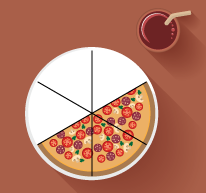
|
Math Clip Art: Fractions--Pizza Slices--Three Sixths | Math Clip Art: Fractions--Pizza Slices--Three SixthsTopicFractions DescriptionThis math clip art image is part of a series illustrating fraction models using pizzas. The image depicts a circular pizza divided into six equal slices, with three slices present and three missing. This visual representation clearly illustrates the fraction three-sixths (3/6), which is equivalent to 1/2. |
Identify and Name Fractions |

|
Math Clip Art: Fractions--Pizza Slices--Three Sixths | Math Clip Art: Fractions--Pizza Slices--Three SixthsTopicFractions DescriptionThis math clip art image is part of a series illustrating fraction models using pizzas. The image depicts a circular pizza divided into six equal slices, with three slices present and three missing. This visual representation clearly illustrates the fraction three-sixths (3/6), which is equivalent to 1/2. |
Identify and Name Fractions |

|
Math Clip Art: Fractions--Pizza Slices--One Sixth | Math Clip Art: Fractions--Pizza Slices--One SixthTopicFractions DescriptionThis math clip art image is part of a series that uses pizza slices to model fractions. The image shows a circular pizza divided into six equal slices, with only one slice present. This visual representation effectively illustrates the fraction one-sixth (1/6). |
Identify and Name Fractions |

|
Math Clip Art: Fractions--Pizza Slices--One Sixth | Math Clip Art: Fractions--Pizza Slices--One SixthTopicFractions DescriptionThis math clip art image is part of a series that uses pizza slices to model fractions. The image shows a circular pizza divided into six equal slices, with only one slice present. This visual representation effectively illustrates the fraction one-sixth (1/6). |
Identify and Name Fractions |
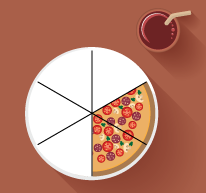
|
Math Clip Art: Fractions--Pizza Slices--Two Sixths | Math Clip Art: Fractions--Pizza Slices--Two SixthsTopicFractions DescriptionThis math clip art image is part of a series illustrating fraction models using pizzas. The image shows a circular pizza divided into six equal slices, with two slices present and four missing. This visual representation effectively demonstrates the fraction two-sixths (2/6). |
Identify and Name Fractions |